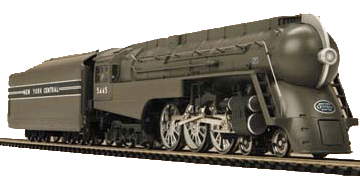|
|
 Posted - February 18 2024 : 8:38:42 PM Posted - February 18 2024 : 8:38:42 PM




|
Some nice steam engines down South.
|
Country:  USA ~
Posts: 7395 ~
Member Since: February 12 2014 ~
Last Visit: December 14 2025 USA ~
Posts: 7395 ~
Member Since: February 12 2014 ~
Last Visit: December 14 2025
|
 Alert Moderator
Alert Moderator
|
|
|
|
 Posted - February 18 2024 : 8:41:02 PM Posted - February 18 2024 : 8:41:02 PM




|
|
Country:  USA ~
Posts: 7395 ~
Member Since: February 12 2014 ~
Last Visit: December 14 2025 USA ~
Posts: 7395 ~
Member Since: February 12 2014 ~
Last Visit: December 14 2025
|
 Alert Moderator
Alert Moderator

|
|
|
|
 Posted - February 18 2024 : 8:46:08 PM Posted - February 18 2024 : 8:46:08 PM




|
More videos from South America.
|
Country:  USA ~
Posts: 7395 ~
Member Since: February 12 2014 ~
Last Visit: December 14 2025 USA ~
Posts: 7395 ~
Member Since: February 12 2014 ~
Last Visit: December 14 2025
|
 Alert Moderator
Alert Moderator

|
|
|
|
 Posted - February 19 2024 : 10:05:15 PM Posted - February 19 2024 : 10:05:15 PM




|
I rode on the Guyaquil and Quito back in 1996. It was different, then.
Seeing the new ties and heavy ballast that replaced the old ties and dirt ballast, I was amazed and happy for the railroad. I found out, though, that the company that invested all that money lost millions of dollars and bellied up.
Watching the videos, I was a bit wistful, though, too. When I went, it was rustic railroading at its finest. We rode on the roof, the cowcatcher and in the cab. Of course, that was a charter, so there was more flexibility. The kind of Rolex Railroading seen in the video does not much appeal to me. I'd rather eat a box lunch on the roof of a boxcar than drink wine from stemware in a hermetically sealed airconditioned diner car.
Here are some pictures of the old G&Q from Duran to Quito:
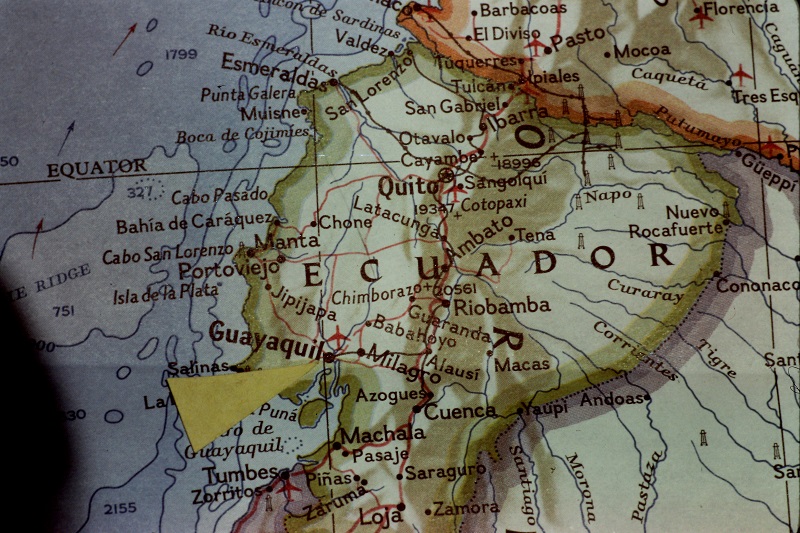
Duran is across the river from Guyaquil, the principal sea port. The railroad begins there, rather than Guyaquil, proper. The railroad heads east across the coastal plain to Bucay (east of Milagro, and not shown on the map), and then climbs up into the Andes, getting into the middle of the mountain range at Alousi. From there, it heads north to Quito.
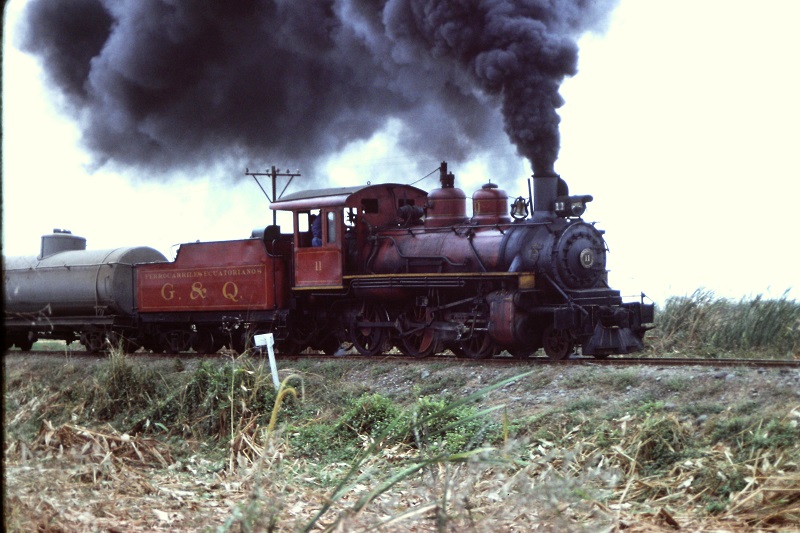
Across the coastal plain, we rode behind No. 11, a small mogul. It was level going and didn't require a larger engine. The railroad is 42-inch guage so equipment is neither very small nor very large.
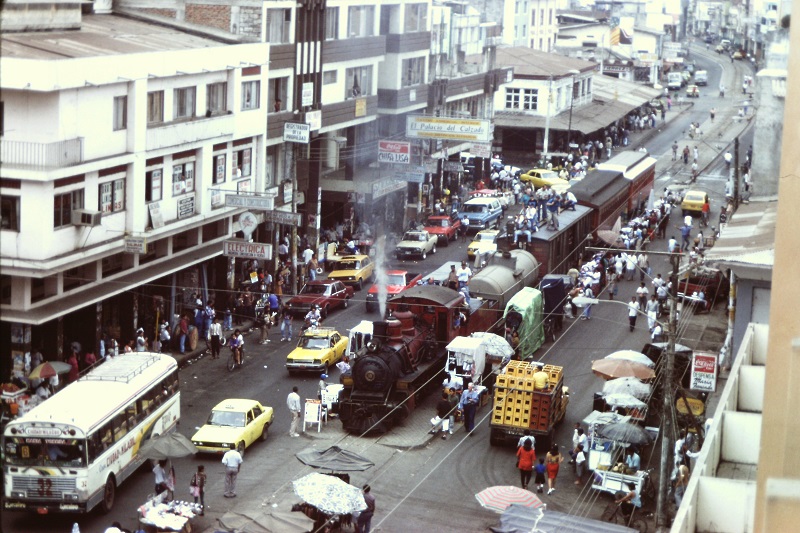
In the city of Milagro, the tracks go down the main street. There's an open-air market in the tracks with merchandise along the tracks. When a train comes, awnings drop and cover the merchandise like tarps, and the train threads its way up the middle. We got this picture from the roof of the drug store. Yes, out of nowhere a bunch of camera-toting tourists paraded through the store, up the steps through the clinic, and up more steps onto the roof. Interestingly for a clinic, the stairs had no railings.
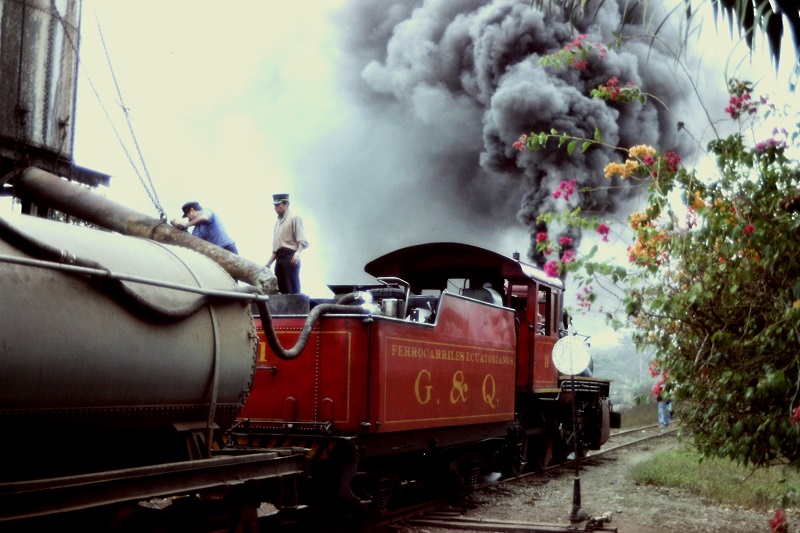
We stopped for water by a beautiful blooming tree.
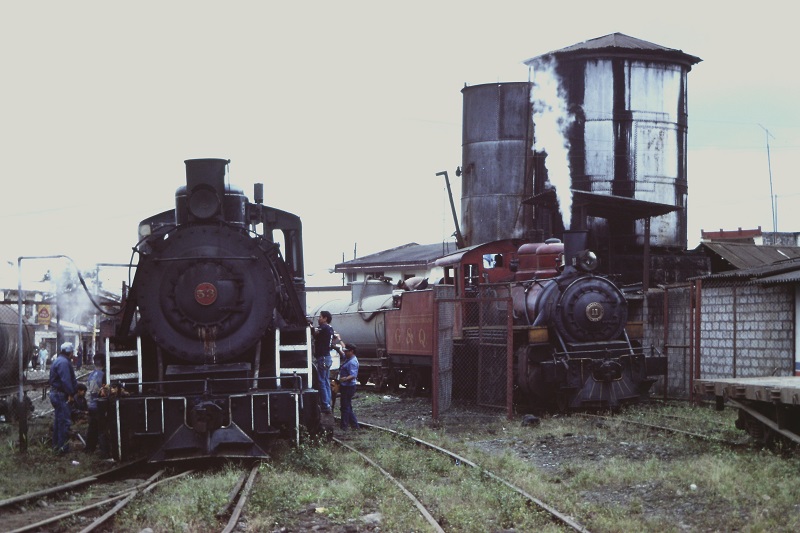
Arriving at Bucay, the little mogul was uncoupled from the train and replaced by 53, a more powerful Andes class Baldwin Consolidation.
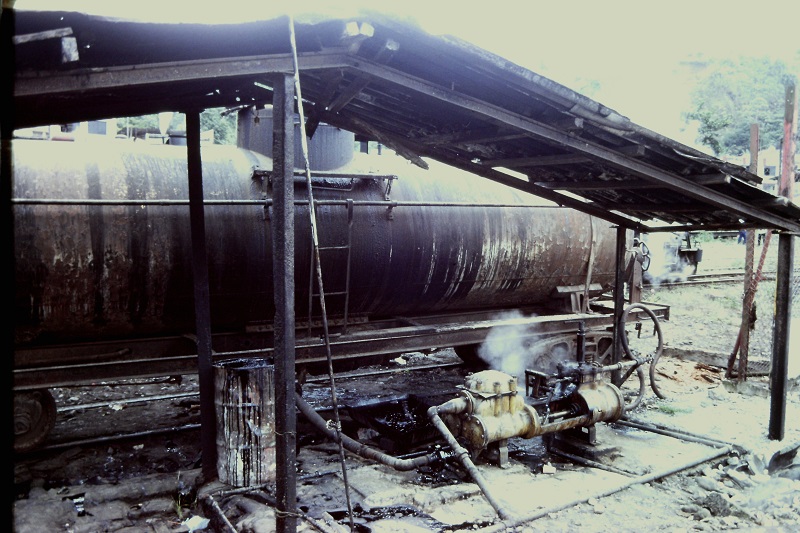
They were still fueling up our noble steed when we arrived. The locomotives burned bunker oil, which is the leftover goo after all the gasoline, diesel, asphalt etc. is removed. It has to be heated to flow. At room temperature it congeals into tar. A steam locomotive supplies steam to heat the oil and run the pump to move the oil from the tank car into the tender.
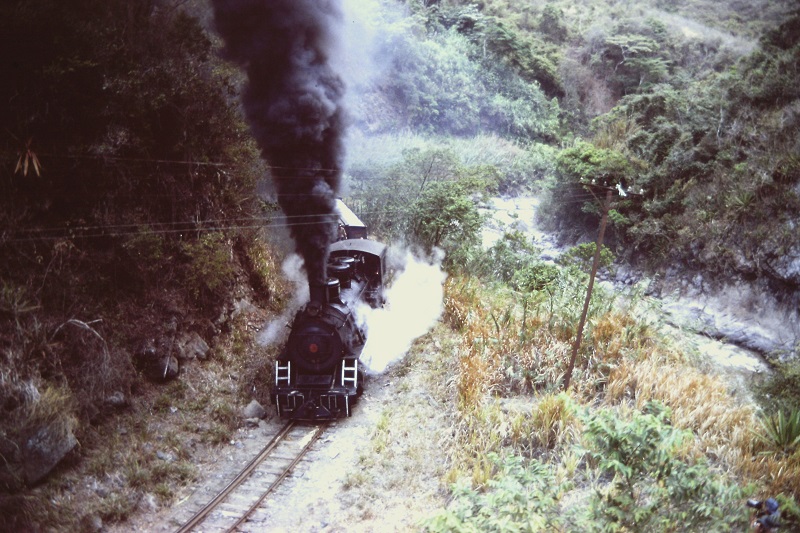
The climb into the Andes follows steep narrow canyons with dense vegitation. Before the railroad was built, this was a slow, dangerous trip, complete with poison snakes.
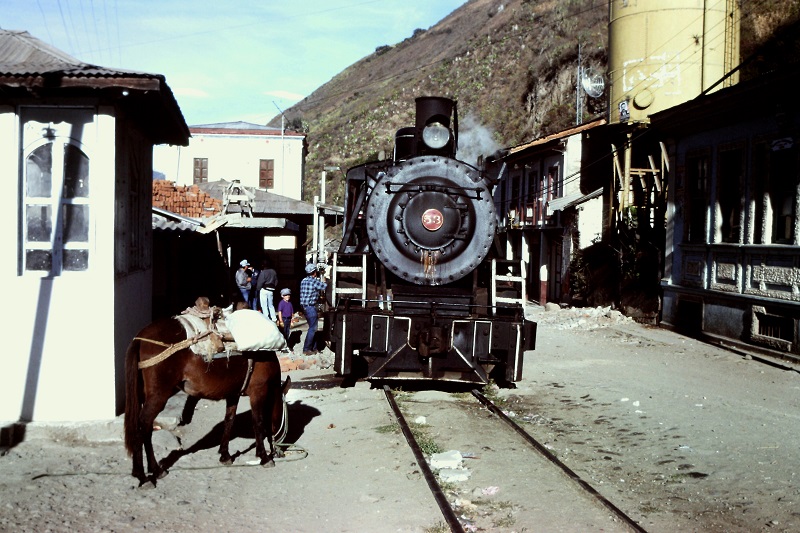
Halfway up into the mountains, we stopped for the night in Huigra. That horse is not some outdated throwback. In the steep mountains and canyons, there will always be places hooves can go and wheels cannot.
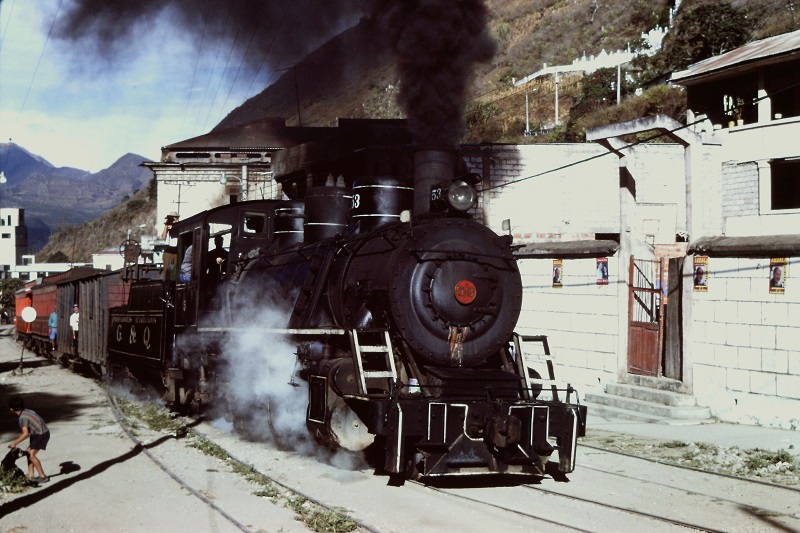
This being a photo charter, there were many occasions when we lined up by the tracks and photographed our train passing by. Here, we're about to leave Huigra.
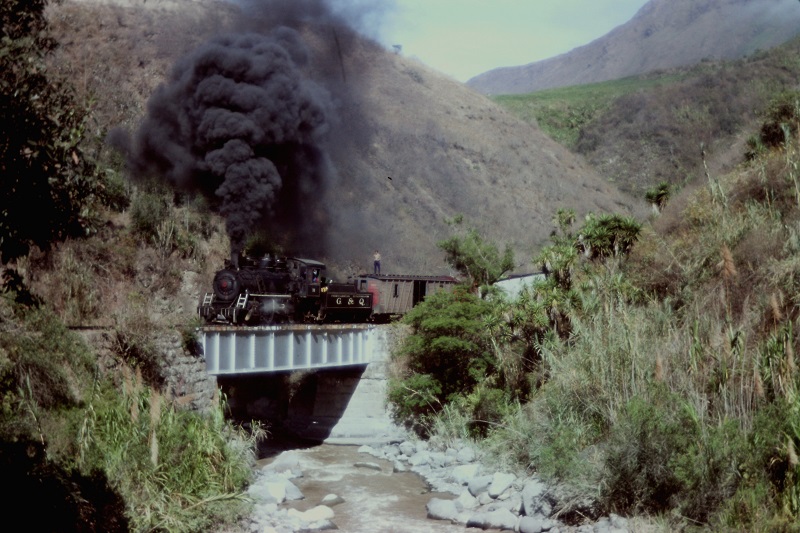
A bridge makes a good photo location.
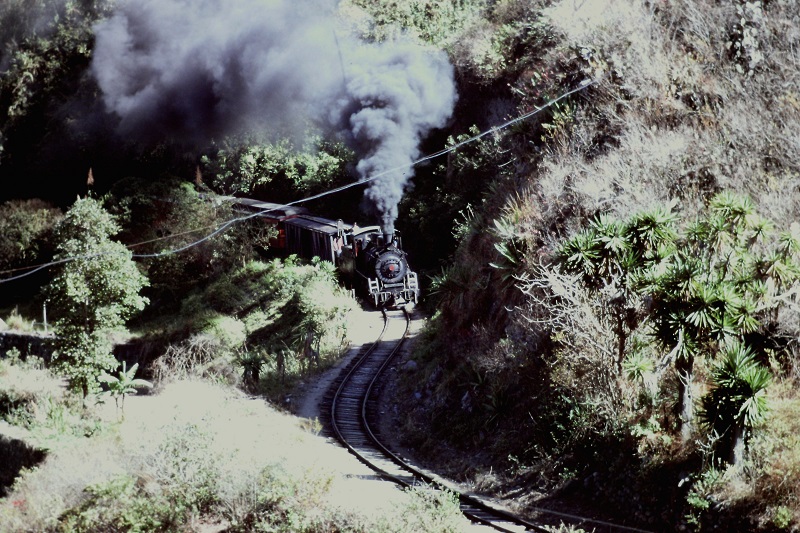
There were many photo stops, this day, to take advantage of the many great photo locations.
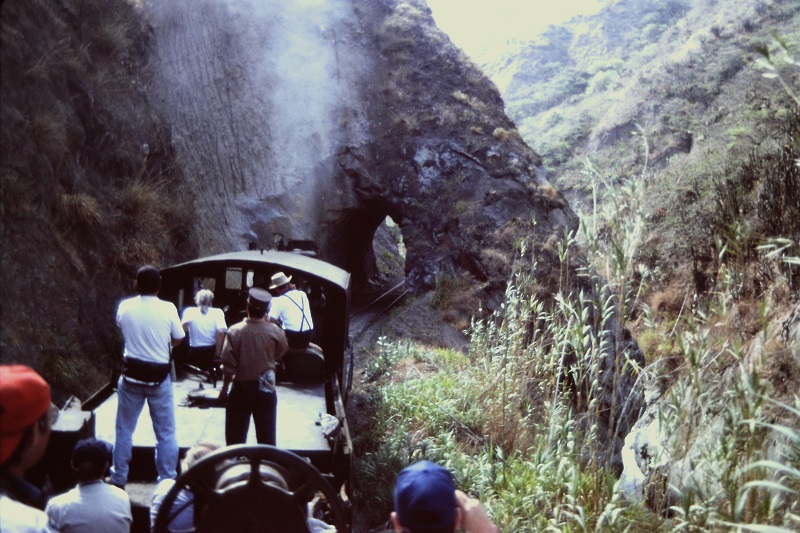
There were a couple of tunnels on the line. I didn't get a picture of the other, but it was longer. Riding on the roof through the tunnel, we were in the hot, dark exhaust of the steam locomotive. The temperature felt like it must have hit 150 degrees (F). That sounds unpleasant, but brief as it was, it was more exciting and impressive.
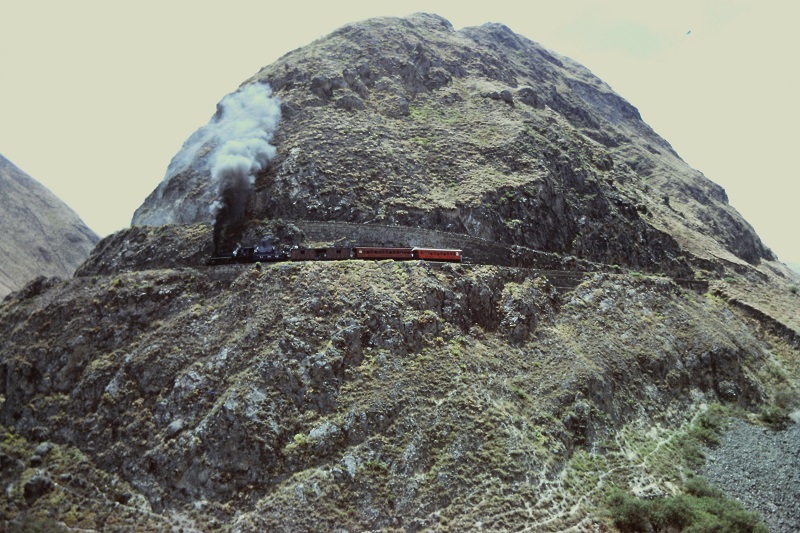
The most famous place on the railroad is the Devil's Nose. The railroad is climbing up the canyon, and the fall rate of the canyon gets too steep, so there's a switch back where the train backs up a sloping sidehill grade, around the end of a ridge, and then switches back again to go forward along the wall of the canyon for a long way before the bottom of the canyon reaches track level, again. When I was in World Geography in high school, I saw a movie of a train going up this, and always wanted to go there, but wouldn't have known how to go about it -- until I saw a magazine ad for this tour.
Here are some more shots showing the progression of the train up the switchback. Our group climbed partway up the opposite canyon wall to get these shots. Our train went up without us, and then came back down and got us.
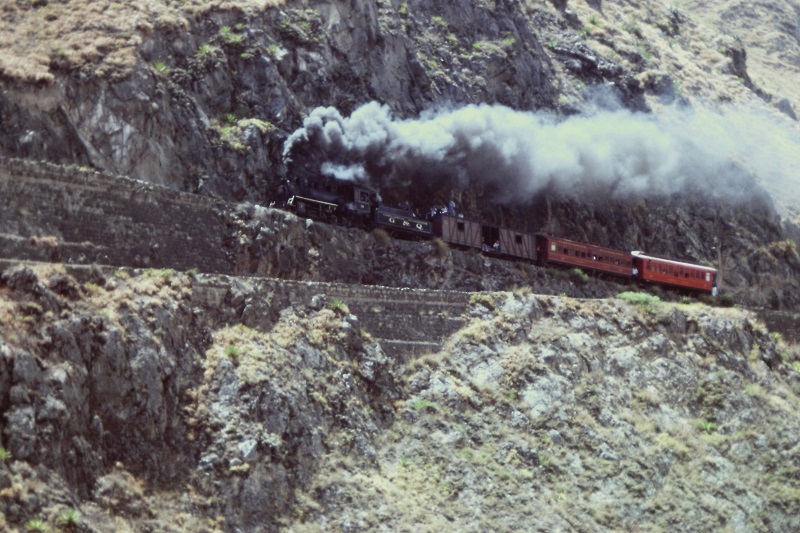
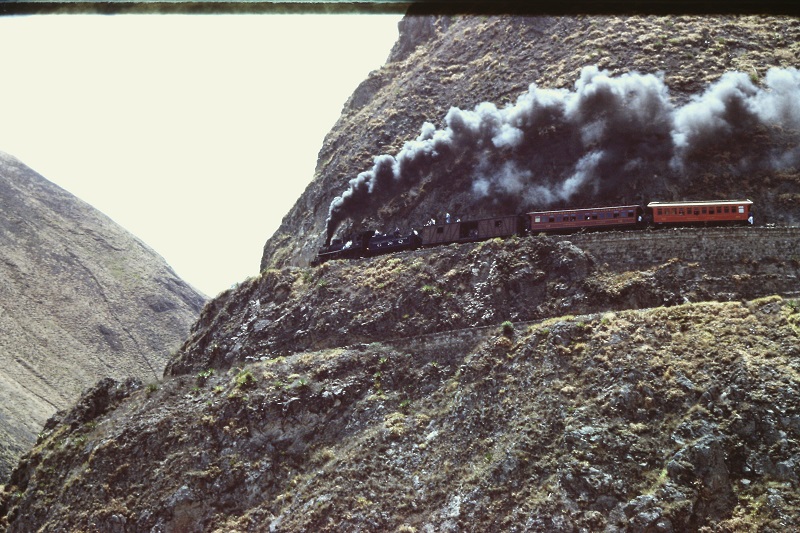
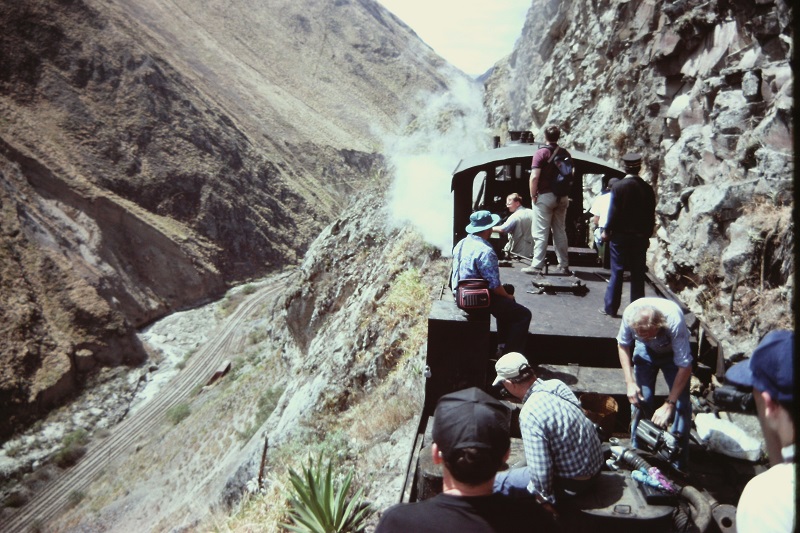
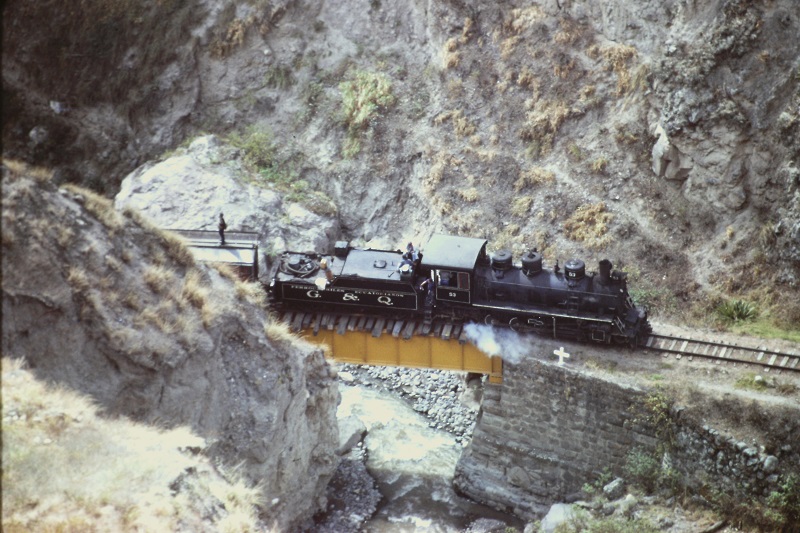
The river catches up to us in elevation below the town of Alousi. The track then has to wind around some looping curves to get up to Alousi. The train took us to the top, and then backed down to the bottom so we could photograph it climbing back up.
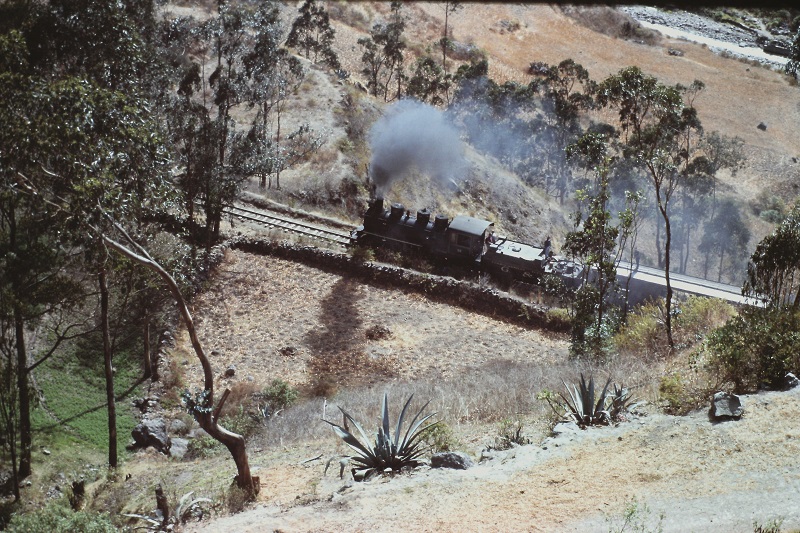
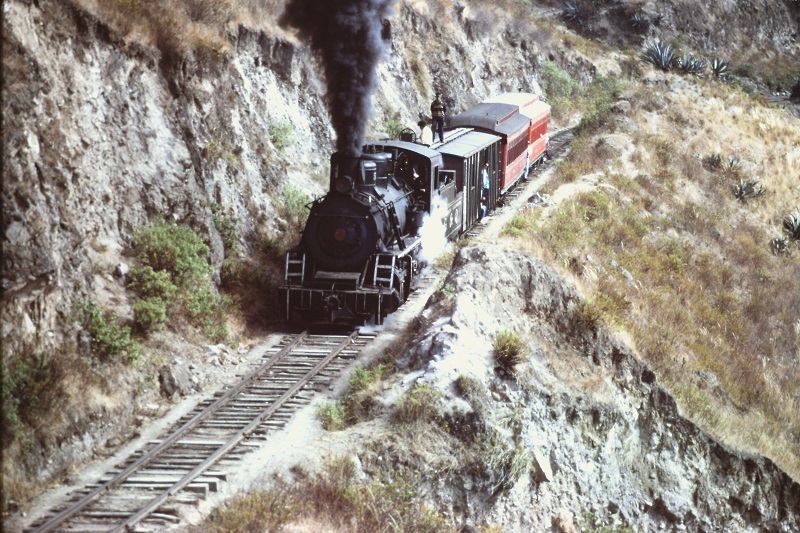
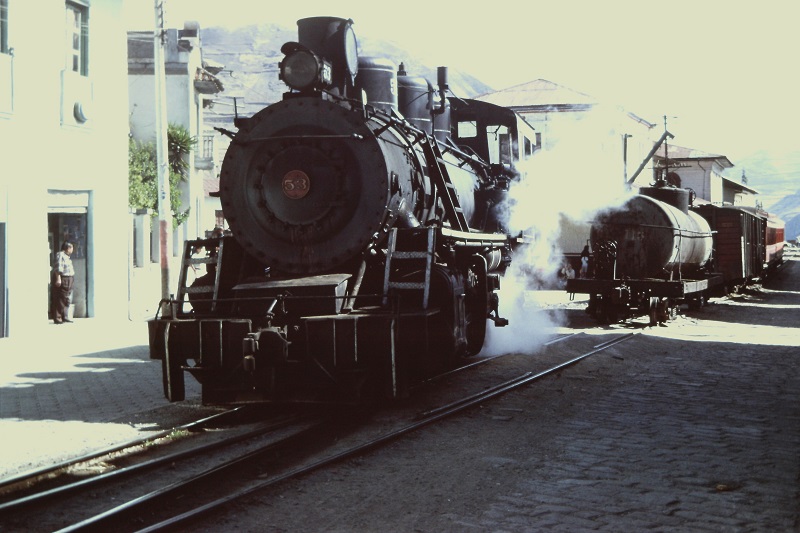
We arrived in Alousi with the tracks running through the streets. At this point, we're between the twin ridges of the Andes, and the railroad turns to the north toware Quito. We stopped here for the night.
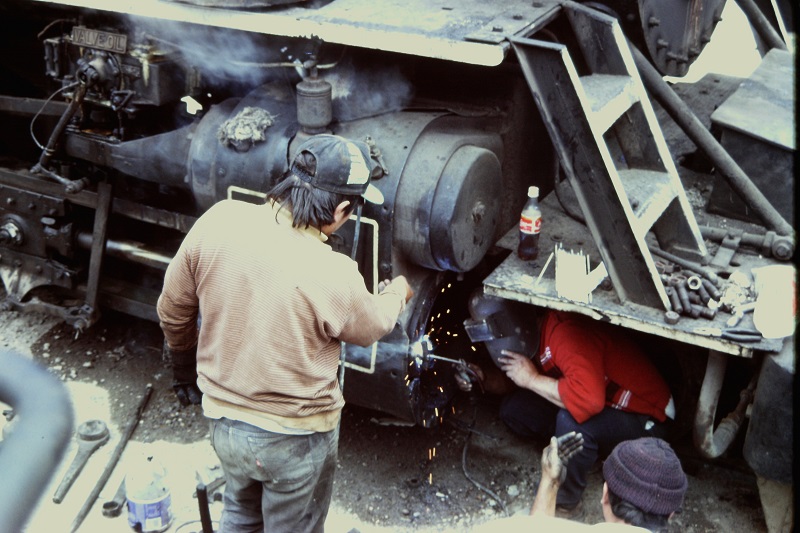
Misfortune struck. During the day, various parts had fallen off of the running gear and been pieced together to get us to Alousi. While the mechanics were putting things back together more permanently, they accidentally slammed the right piston into the front right piston head. This shattered the head, and sheared the bolts flush with the cylinder. Our crew had to weld broken off bolts onto the sheared bolts to unscrew them. It was a long process, and one that would have tried the patience of a saint, but they stuck with it for about 20 hours and got the thing fixed.
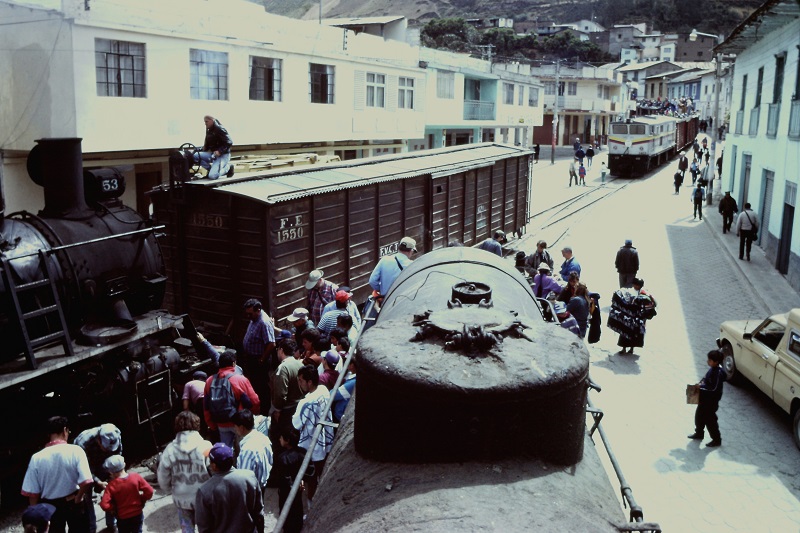
We were broken down right in the way, and the Mixto (mixed passenger and freight train) came along. From below, a railbus also arrived.
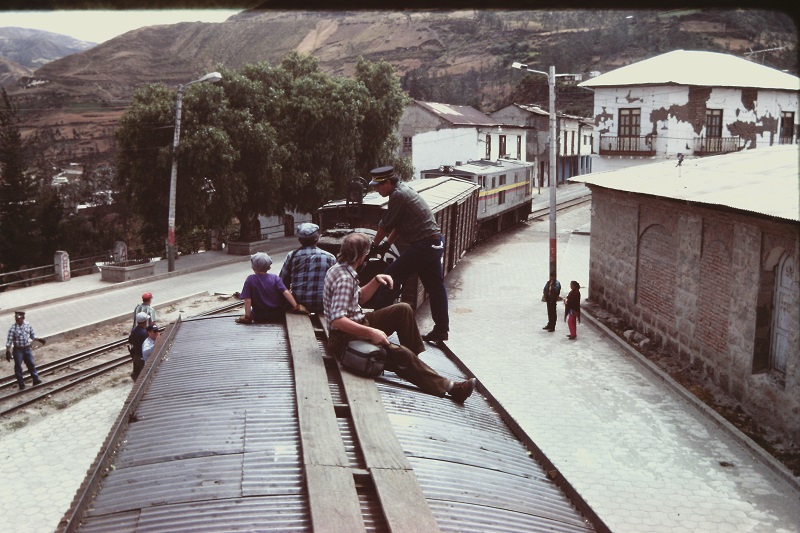
After much switching, the Mixto was past our train, and the engine was still by the station where there was electricity for the welder.
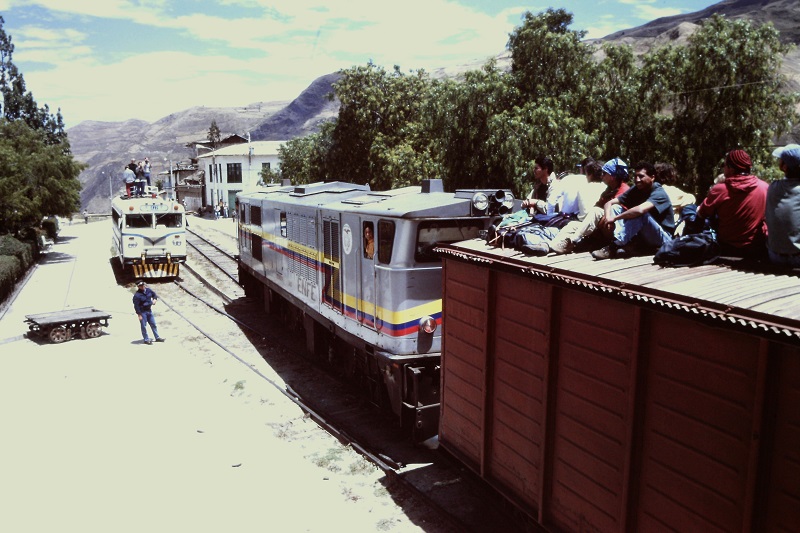
The railbus is in a passing siding. The Mixto continued, and then the railbus continued uphill. The bluebird bus company had a factory in Ecuador so that by building buses with Ecuadoran wages, they could be affordable to Ecuatorianos. The railroad converted the buses to railcars.
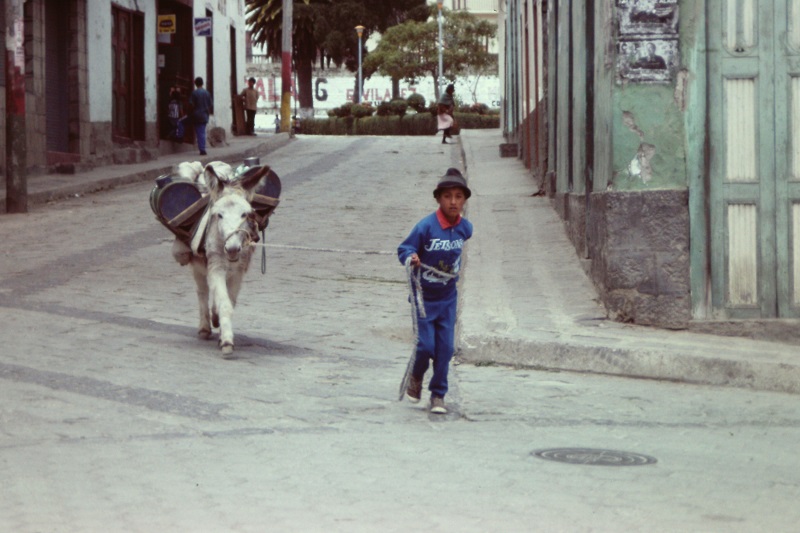
The locomotive was back together and we were lined up for a photo run-by of the train, when down the street came this pack burro led by a boy in a Jetsons sweatsuit.
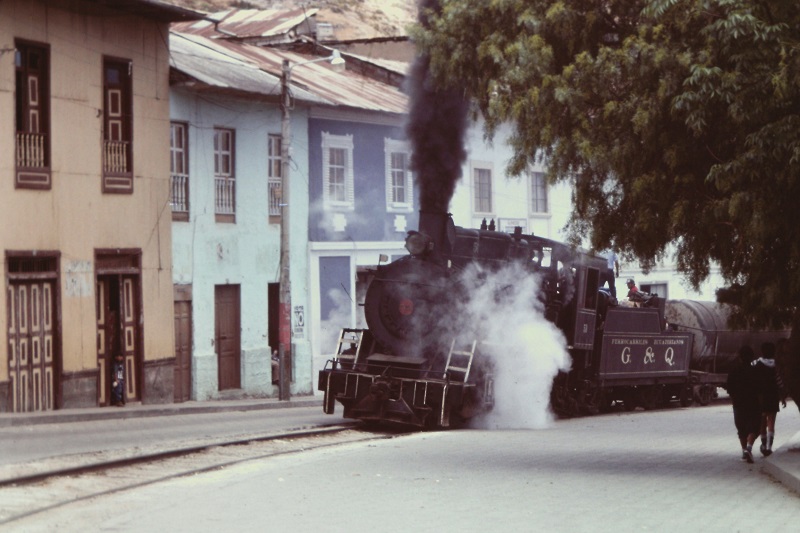
This was the run-by for which we were set up when the burro came along.
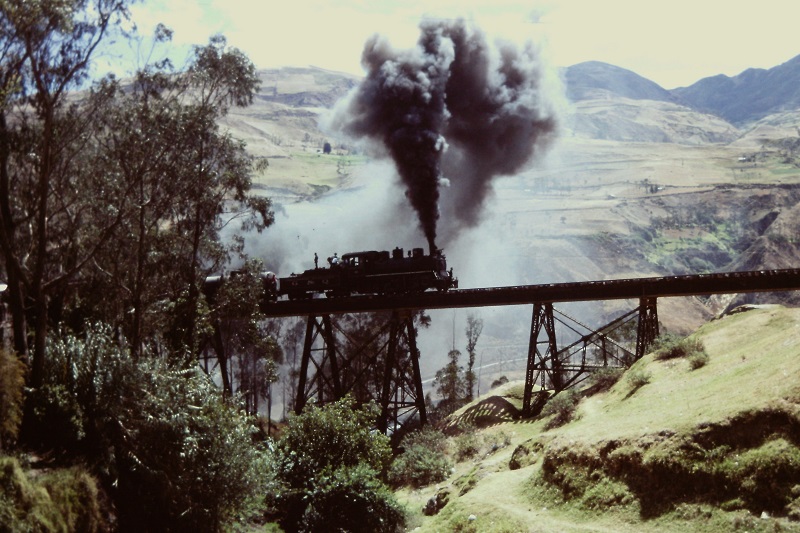
Just uphill of Alousi, was this picturesque bridge.
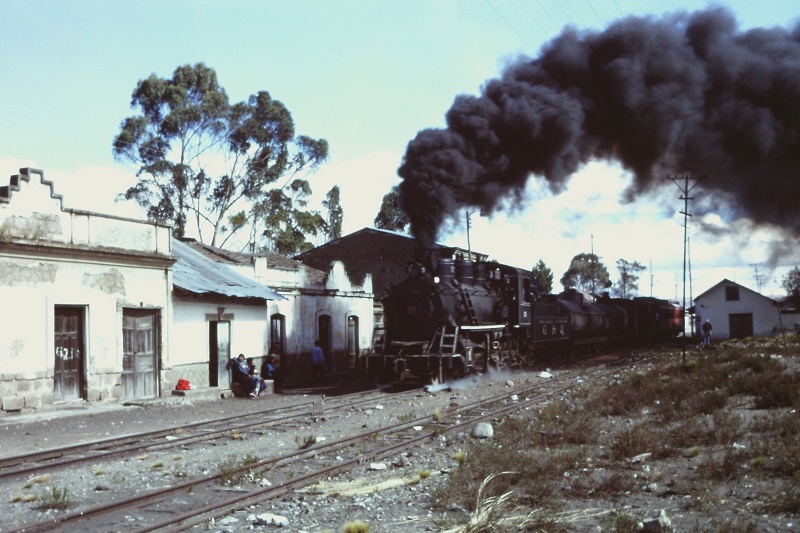
We climbed a long way up a canyon to this town that looked like something from a Spaghetti Western, and stopped for more photos.
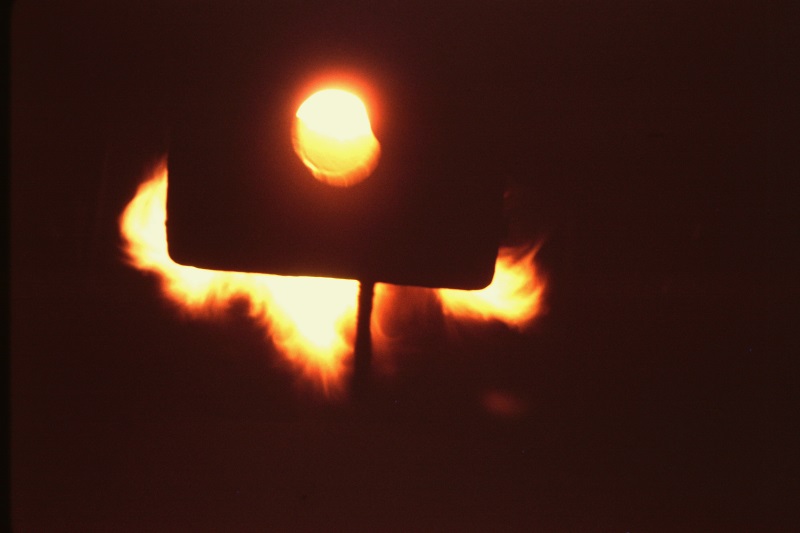
We got a late start because of the repairs and were still a ways out from Riobamba when night set in. I moved from the roof to the cab, when things got cold at night. The engine was working hard and they were firing hard. Sometimes fire would flicker out the firebox door and across the floor of the cab. The flame was there so briefly, that it could wash over your feet and ankles without harming anything.
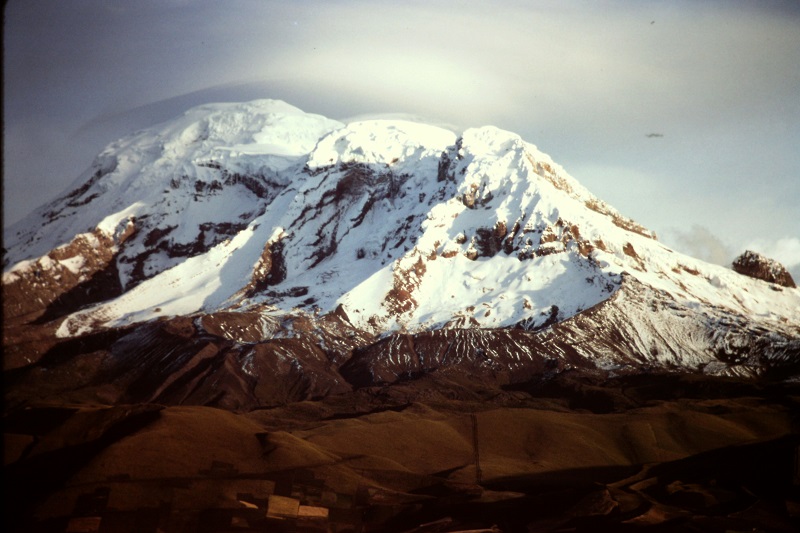
We spent the night a little outside of Riobamba, and up the road a bit from our acommodations, was a place where one could see Mt. Chimborazo in the morning light. Chimborazo is not the highest mountain above mean sea level, nor even the highest in South America, but it's the farthest you can be from the center of the Earth and still be on the ground. The Earth's rotation causes the equator to bulge outward enough that, with Everest being at a higher latitude, Chimborazo is still farther from the center, even though it's more than a mile lower.
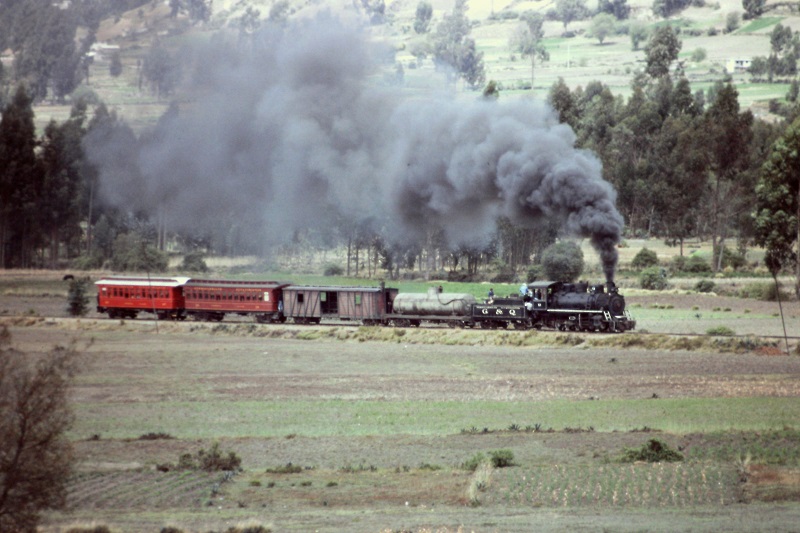
We passed the town of Siberia and stopped for more photos.
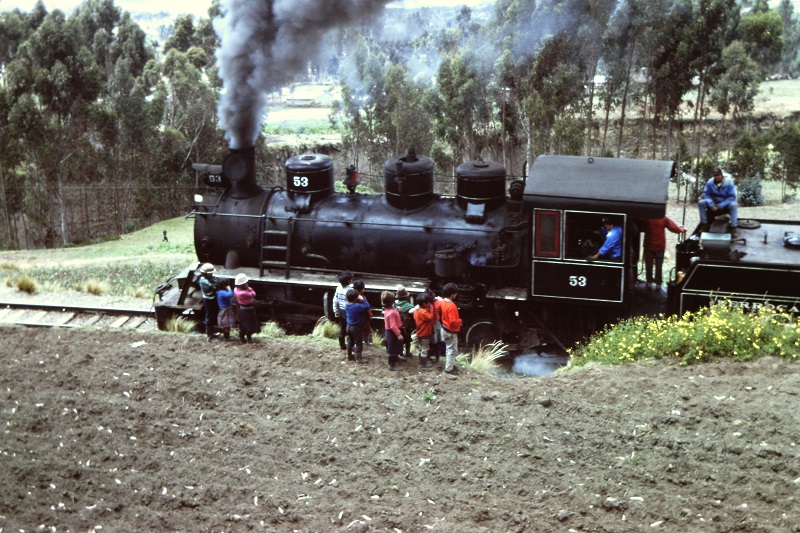
It was not unusual for the sight of a train to empty out the school. These kids came out to see the train. Some of the bigger kids even ran after us when we left, and caught up with us at the next photo stop. They're in good shape, covering that much ground so fast, almost two miles above sea level.
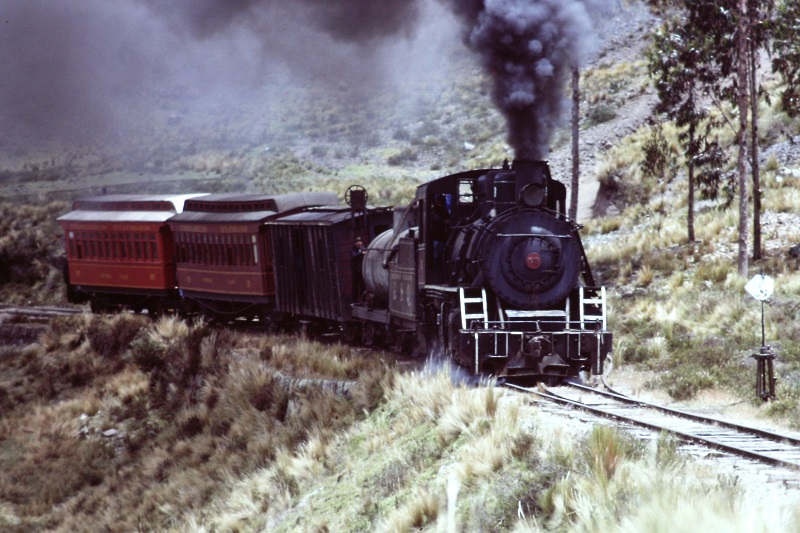
This location provided a nice, clear view of the train.
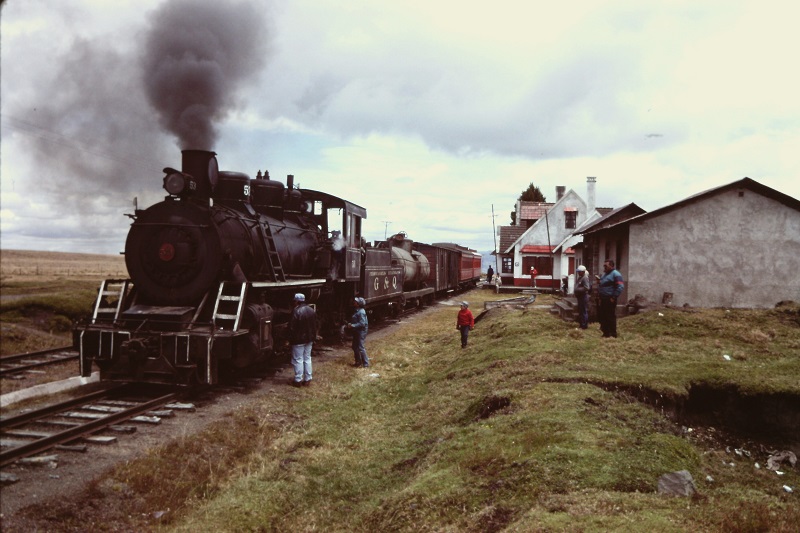
Urbina Summit is the highest place on the railroad, and the jumping off point to climb Chimborazo, which of course, we didn't do.
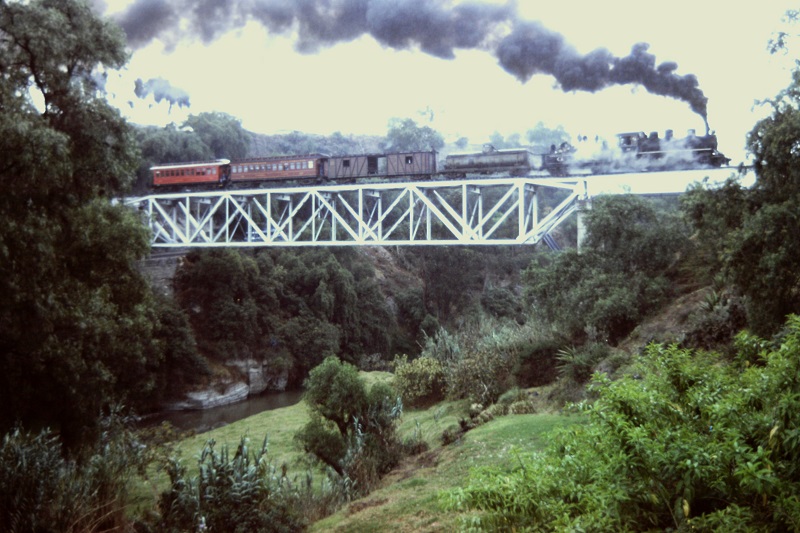
We stopped for a night in Ambato, and then photographed our train on an impressive bridge on the way out of town in the morning.
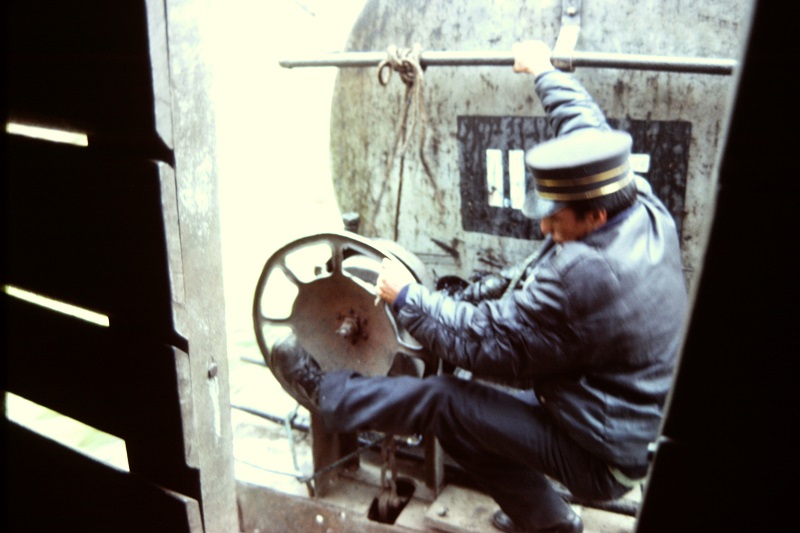
The brake system was designed for 90 psi. The pump was producing less than half that, so the crew did not dare do light air brake applications. Any leak in the system could turn that into full emergency, a very sudden stop. For light applications, the crew did braking the old-fashioned way.
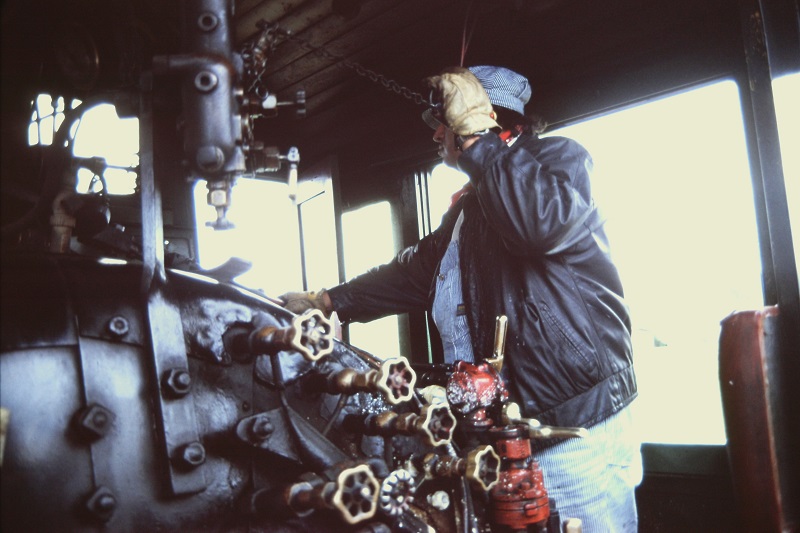
I took another ride in the cab in the daytime. This is our engineer.
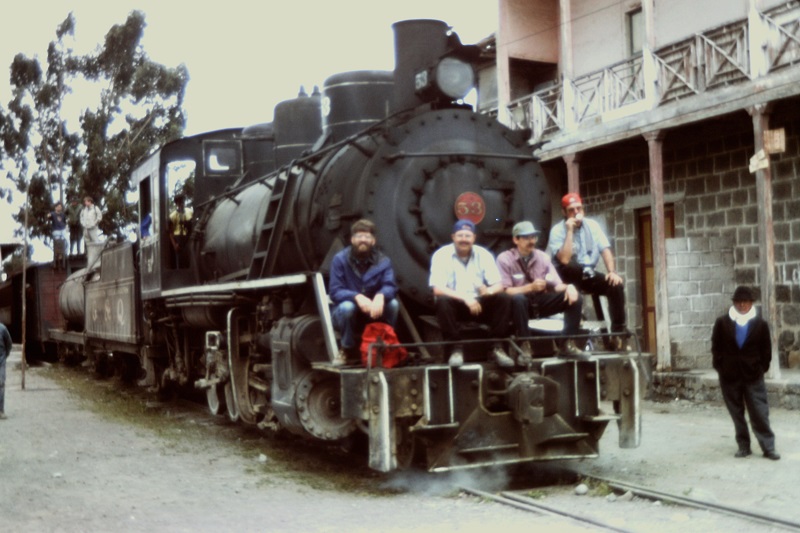
Pardon the blurry picture. I handed the camera off to a railroad official who probably didn't know how long the shutter speed was in that light. For some distance I joined the group that did most of the ride on the cowcatcher.
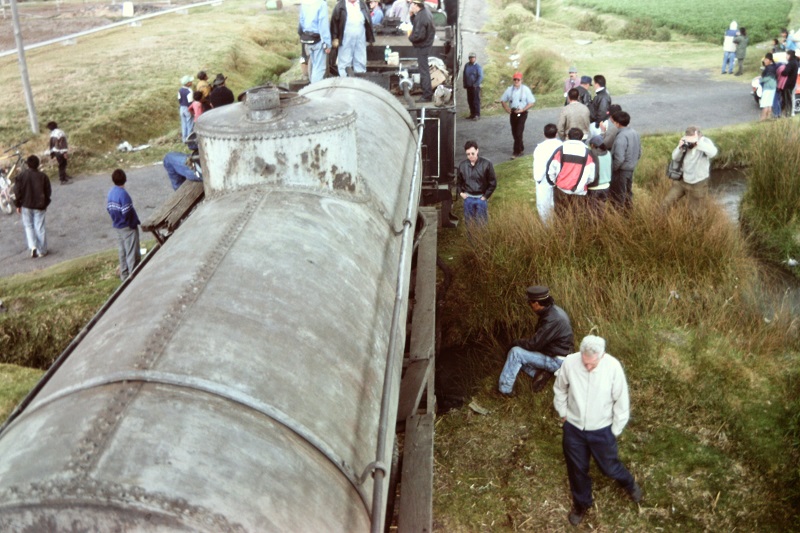
Water tinks are too few on this stretch of track, so we stopped at an irrigation ditch. We had a gasoline powered water pump and could take water from a variety of places.
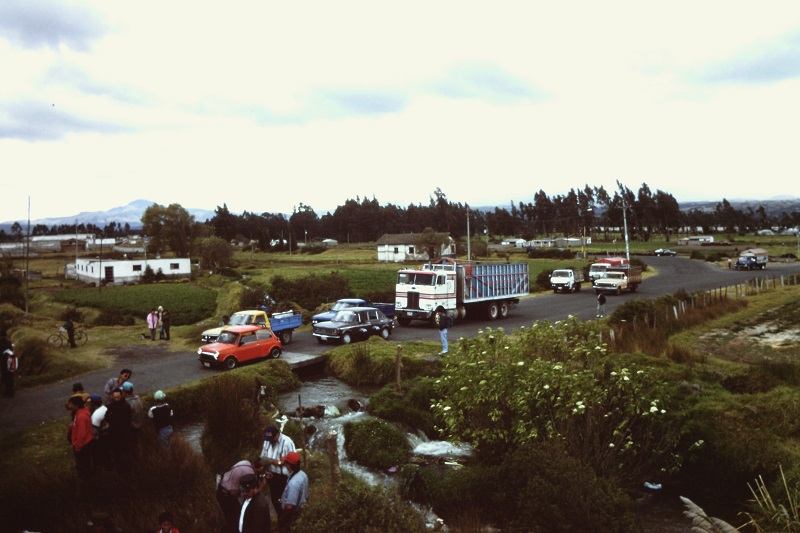
For about a half hour, we were blocking the road. No one seemed beside himself with impatience. I had the impression that Equatorianos were a bit less uptight about getting in each other's way than we Norteamericanos are.
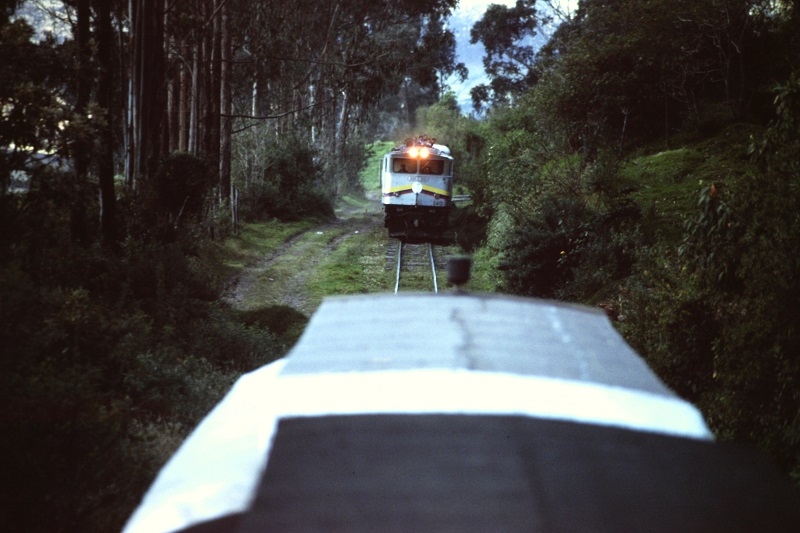
We're a ways out of Quito, and the Mixto is following us on a pretty short headway.
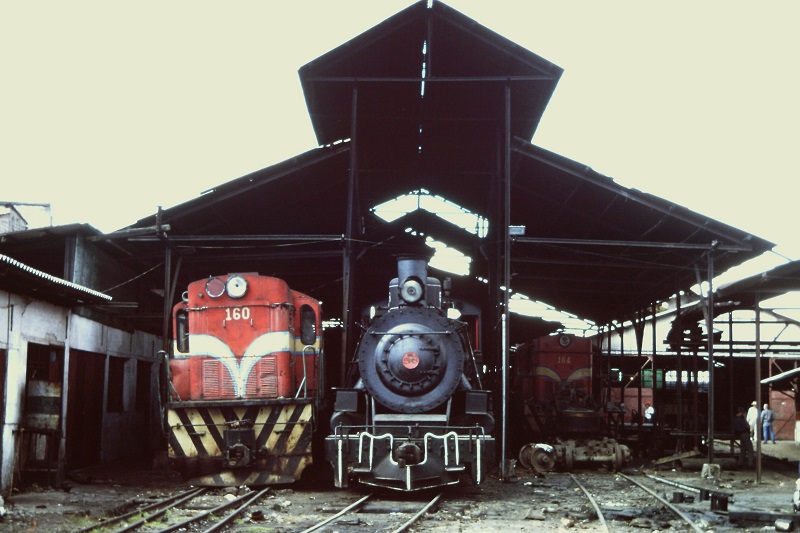
We've reached Quito, the capital, and are visiting the railroad shops the next morning. The steam engine is number 58, which appears in the video on top of this thread. The Diesel is an old ALCO. It has a worn out supercharger, a part that would have cost $70,000 dollars at a time when the railroad's whole budget for the year was about $100,000. It's been sitting idle for some time. In fact for a while, the railroad switched back to steam from diesel, because they could afford to repair the steam engines. A little before I was there, they got some Alstom diesels from France, and I think got them free as some sort of foreign aid.
Carpe Manana!
|
Country:  USA ~
Posts: 2411 ~
Member Since: September 17 2013 ~
Last Visit: December 12 2025 USA ~
Posts: 2411 ~
Member Since: September 17 2013 ~
Last Visit: December 12 2025
|
 Alert Moderator
Alert Moderator

|
|
|
|
 Posted - February 20 2024 : 6:50:11 PM Posted - February 20 2024 : 6:50:11 PM




|
Fascinating photos Don. Thank you for sharing them with us.
Certainly daring to ride on top of the train.
|
Country:  USA ~
Posts: 7395 ~
Member Since: February 12 2014 ~
Last Visit: December 14 2025 USA ~
Posts: 7395 ~
Member Since: February 12 2014 ~
Last Visit: December 14 2025
|
 Alert Moderator
Alert Moderator

|
|
|
|
 Posted - February 20 2024 : 10:36:57 PM Posted - February 20 2024 : 10:36:57 PM




|
To me, the scary part in that last video is how many people are crowded onto the roof. The guys taking the tickets had their work cut out for them climbing over the crowd. Also, it looks like you just have to sit down and stay put. On the charter we had room to move around some.
Carpe Manana!
|
Country:  USA ~
Posts: 2411 ~
Member Since: September 17 2013 ~
Last Visit: December 12 2025 USA ~
Posts: 2411 ~
Member Since: September 17 2013 ~
Last Visit: December 12 2025
|
 Alert Moderator
Alert Moderator

|
|
|
|
 Posted - February 21 2024 : 12:48:59 AM Posted - February 21 2024 : 12:48:59 AM




|
think I saw a Nat Geo Special on trains about that switchback railroad 
|
Country:  USA ~
Posts: 14977 ~
Member Since: February 23 2009 ~
Last Visit: December 14 2025 USA ~
Posts: 14977 ~
Member Since: February 23 2009 ~
Last Visit: December 14 2025
|
 Alert Moderator
Alert Moderator

|
|
|
|
 Posted - February 21 2024 : 08:38:55 AM Posted - February 21 2024 : 08:38:55 AM




|
Not for the faint of heart.
|
Country:  USA ~
Posts: 7395 ~
Member Since: February 12 2014 ~
Last Visit: December 14 2025 USA ~
Posts: 7395 ~
Member Since: February 12 2014 ~
Last Visit: December 14 2025
|
 Alert Moderator
Alert Moderator

|
|
|
|
|
|
